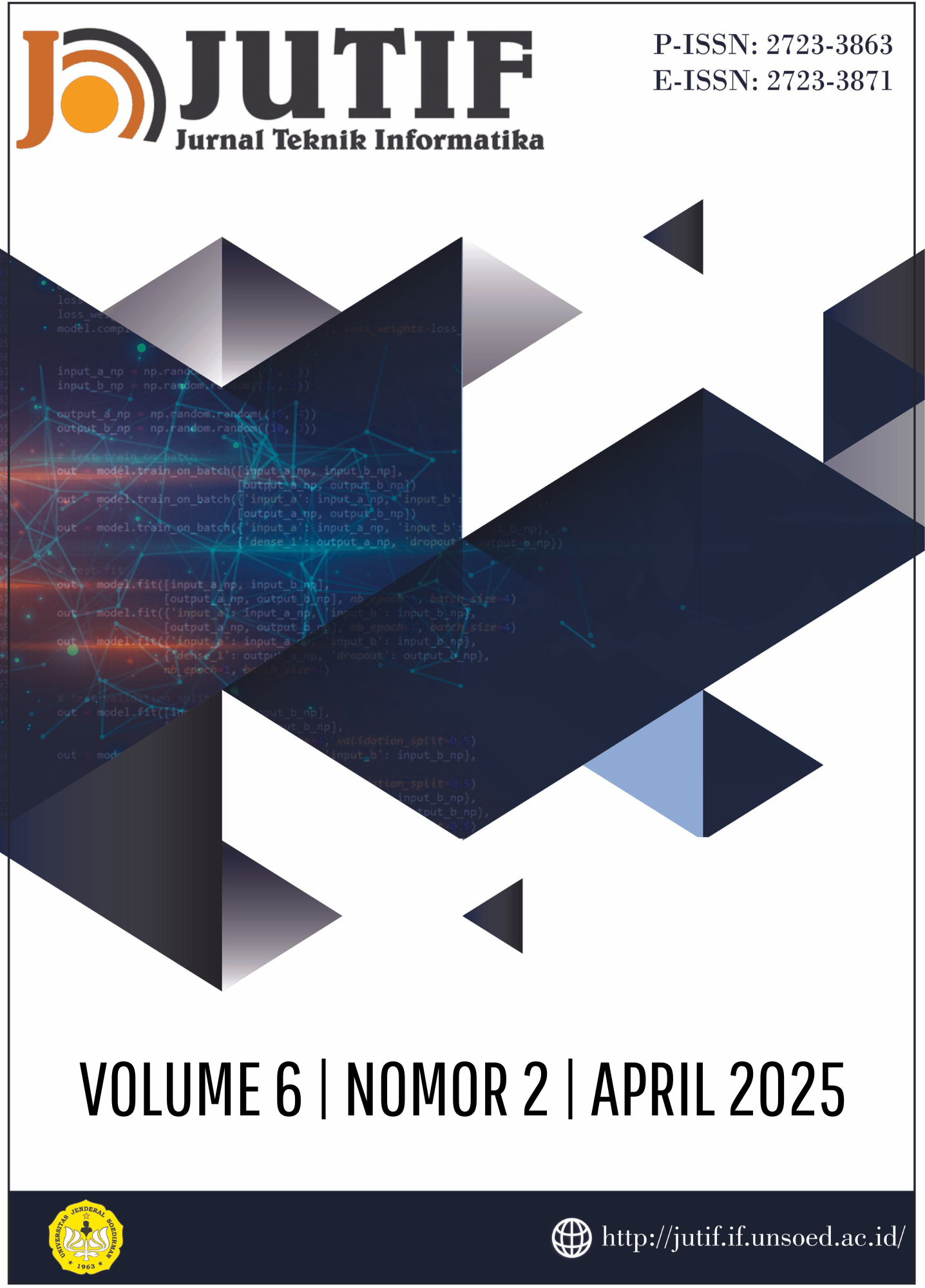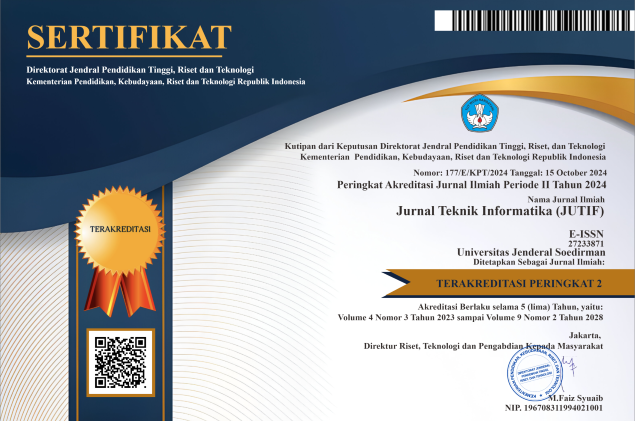Enhancing Prediction of Treatment Duration in New Tuberculosis Cases: A Comprehensive Approach with Ensemble Methods and Medication Adherence
DOI:
https://doi.org/10.52436/1.jutif.2025.6.2.4263Keywords:
Ensemble Method, Machine Learning, Prediction Model of Treatment Period, Prognosis of TB, Treatment Duration of TB PatientsAbstract
Tuberculosis (TB) remains a significant global health problem, with treatment duration varying among patients. TB patients have difficulty following a long-term treatment regimen. After the final diagnosis is determined, it is necessary to know the predicted duration of treatment for a patient. By increasing patient compliance with taking medication, the percentage of TB patients will increase, and this can reduce cases of multi-drug resistant patients and dropouts. This study aims to build a prediction model for the duration of treatment for new cases of Pulmonary TB patients by adding medication compliance parameters using the ensemble method. The research methodology uses CRISP-DM. This study begins with identifying problems and objectives, collecting data, preprocessing and analyzing data, modeling, evaluating, and validating models. The results showed that adding medication compliance parameters can improve model performance. However, the results of model exploration with feature selection techniques and various ensemble methods have not shown good performance. The medication adherence parameters used in this study are the number of medications swallowed in Phase I and Anti-Tuberculosis drug compliance in Phase I. These parameters had never been used in previous studies. The prediction model can be used as an early warning for a patient. If a patient is predicted to have a treatment duration of more than six months, then the patient will receive stricter drug intake supervision. Thus, this proposed model is expected to help achieve the target of eliminating Tuberculosis in 2030 to reduce the death rate by 90% compared to 2019.
Downloads
References
WHO, ‘Global Tuberculosis Report 2021’, 2021.
Kemenkes RI, Strategi Nasional Penanggulangan Tuberkulosis di Indonesia 2020-2024. 2020.
W. Xu, W. Lu, Y. Zhou, L. Zhu, H. Shen, and J. Wang, ‘Adherence to anti-tuberculosis treatment among pulmonary tuberculosis patients: A qualitative and quantitative study’, BMC Health Serv Res, vol. 9, 2009, doi: 10.1186/1472-6963-9-169.
Y. Jiang et al., ‘Factors associated with loss to follow-up before and after treatment initiation among patients with tuberculosis: A 5-year observation in China’, Front Med (Lausanne), vol. 10, 2023, doi: 10.3389/fmed.2023.1136094.
PDPI, Pedoman Diagnosis dan Penatalaksanaan di Indonesia, 2nd ed. 2021.
E. E. Lutge, C. S. Wiysonge, S. E. Knight, D. Sinclair, and J. Volmink, ‘Incentives and enablers to improve adherence in tuberculosis’, Sep. 03, 2015, John Wiley and Sons Ltd. doi: 10.1002/14651858.CD007952.pub3.
R. Andarwati, Masrah, and Z. I. Fauzi, ‘Analisis Faktor Keberhasilan Penyembuhan Tuberkulosis Paru’, Jurnal Ilmiah Pannmed, vol. 15, no. 3, pp. 337–344, 2020, doi: https://doi.org/10.36911/pannmed.v15i3.
M. Masita and H. Andriani, ‘Analisis Determinan Kejadian Loss to Follow-up (Putus Berobat) pada Pasien Tuberkulosis Paru: Literature Review’, Media Publikasi Promosi Kesehatan Indonesia (MPPKI), vol. 6, no. 5, 2023.
R. Rusdah and B. Agni Bregastantyo, ‘Model Prognosis Masa Pengobatan Pasien Tuberkulosis dengan Metode C4.5’, Jurnal Teknologi Informasi dan Ilmu Komputer (JTIIK), vol. 10, no. 6, pp. 1197–1204, Dec. 2023, doi: 10.25126/jtiik.2023107393.
I. Azizah, ‘Determinan Lama Waktu Kesembuhan Pada Kategori I Di RSUD Ungaran Kabupaten Semarang’, 2019. Accessed: Feb. 24, 2025. [Online]. Available: https://lib.unnes.ac.id/36449/
Rusdah, B. A. Bregastantyo, and J. E. Riwurohi, ‘Prognosis Model of The Treatment Period of Tuberculosis Patients with Medication Compliance Parameters using The Gradient Boosting Algorithm’, in 2023 6th International Seminar on Research of Information Technology and Intelligent Systems (ISRITI), Batam: IEEE, Dec. 2023, pp. 220–225. doi: 10.1109/ISRITI60336.2023.10467254.
F. Gorunescu, ‘Data Mining Techniques in Computer-Aided Diagnosis : Non-Invasive Cancer Detection’, World Acad Sci Eng Technol, vol. 34, pp. 280–283, 2007, doi: doi.org/10.5281/zenodo.1059721.
R. Amran, W. Abdulkadir, and M. Madania, ‘Tingkat Kepatuhan Penggunaan Obat Anti Tuberkulosis Pada Pasien Di Puskesmas Tombulilato Kabupaten Bone Bolango’, Indonesian Journal of Pharmaceutical Education, vol. 1, no. 1, pp. 57–66, 2021, doi: 10.37311/ijpe.v1i1.10123.
M. S. Zamaa, D. P. Windasari, E. P. Pawerusi, and Z. Iskandar, ‘Hubungan Dukungan Keluarga dengan Kepatuhan Minum Obat Pada Pasien Tuberkulosis’, Jambura Nurisng Journal, vol. 5, no. 2, pp. 2656–4653, 2023, doi: 10.37311/jnj.v5i2.19547.
M. Fadel and A. Wibowo, ‘Application of Machine Learning in Predicting Employee Discipline Violations in Financial’, Jurnal Teknik Informatika (JUTIF), vol. 5, no. 1, pp. 171–178, 2024, doi: 10.52436/1.jutif.2024.5.1.1229.
N. N. Marpid, Y. I. Kurniawan, and S. P. Rahayu, ‘Analisis Prediksi The Movie Database Rating Film dengan Menggunakan Ensemble Learning Menggunakan Metode Random Forest Regression’, Jurnal Teknik Informatika (JUTIF), vol. 6, no. 1, pp. 1–10, Feb. 2025, doi: 10.52436/1.jutif.2025.6.1.1563.
M. H. L. F. da Silva Barros et al., ‘Benchmarking machine learning models to assist in the prognosis of tuberculosis’, Informatics, vol. 8, no. 2, pp. 1–17, 2021, doi: 10.3390/informatics8020027.
E. B. Postnikov, D. A. Esmedljaeva, and A. I. Lavrova, ‘A CatBoost machine learning for prognosis of pathogen’s drug resistance in pulmonary tuberculosis’, LifeTech 2020 - 2020 IEEE 2nd Global Conference on Life Sciences and Technologies, no. LifeTech, pp. 86–87, 2020, doi: 10.1109/LifeTech48969.2020.1570619054.
V. C. Osamor and A. F. Okezie, ‘Enhancing the weighted voting ensemble algorithm for tuberculosis predictive diagnosis’, Sci Rep, vol. 11, no. 1, pp. 1–11, 2021, doi: 10.1038/s41598- 021-94347-6.
R. Rusdah, E. Winarko, and R. Wardoyo, ‘Predicting The Suspect of New Pulmonary Tuberculosis Case using SVM , C5 . 0 and Modified Moran ’ s I’, International Journal of Computer Science and Network Security (IJCSNS), vol. 17, no. 12, pp. 164–171, 2017.
M. Ayaz, F. Shaukat, and G. Raja, ‘Ensemble learning based automatic detection of tuberculosis in chest X-ray images using hybrid feature descriptors’, Phys Eng Sci Med, vol. 44, no. 1, pp. 183–194, 2021, doi: 10.1007/s13246-020-00966-0.
K. M. Liao, C. F. Liu, C. J. Chen, J. Y. Feng, C. C. Shu, and Y. S. Ma, ‘Using an Artificial Intelligence Approach to Predict the Adverse Effects and Prognosis of Tuberculosis’, Diagnostics, vol. 13, no. 6, Mar. 2023, doi: 10.3390/diagnostics13061075.
Y. Luo et al., ‘Development of diagnostic algorithm using machine learning for distinguishing between active tuberculosis and latent tuberculosis infection’, BMC Infect Dis, vol. 22, no. 1, Dec. 2022, doi: 10.1186/s12879-022-07954-7.
O. B. Poirion, Z. Jing, K. Chaudhary, S. Huang, and L. X. Garmire, ‘DeepProg: an ensemble of deep-learning and machine-learning models for prognosis prediction using multi-omics data’, Genome Med, vol. 13, no. 1, pp. 1–15, 2021, doi: https://doi.org/10.1186/s13073-021-00930-x.
B. Abdualgalil, S. Abraham, and W. M. Ismael, ‘An Efficient Machine Learning Techniques as Soft Diagnostic for Tuberculosis Classification Based on Clinical Data’, Journal of Scientific Research, vol. 66, no. 02, pp. 61–67, 2022, doi: 10.37398/jsr.2022.660209.
J. Chen et al., ‘Predictive machine learning models for anticipating loss to follow-up in tuberculosis patients throughout anti-TB treatment journey’, Sci Rep, vol. 14, no. 1, p. 24685, Dec. 2024, doi: 10.1038/s41598-024-74942-z.
T. F. Monaghan et al., ‘Foundational statistical principles in medical research: Sensitivity, specificity, positive predictive value, and negative predictive value’, Medicina (B Aires), vol. 57, no. 5, 2021, doi: 10.3390/medicina57050503.
R. A. K. Wardhani, ‘Hubungan Pengetahuan dan Motivasi dengan Kepatuhan Minum OAT pada Penderita Tuberkulosis Paru di Puskesmas Mangunjaya Kabupaten Bekasi Tahun 2022’, Fakultas Kedokteran, UIN Syarif Hidayatullah Jakarta, Jakarta, 2022.
Additional Files
Published
How to Cite
Issue
Section
License
Copyright (c) 2025 Rusdah Rusdah, Painem Painem, Dewi Kusumaningsih

This work is licensed under a Creative Commons Attribution 4.0 International License.



























